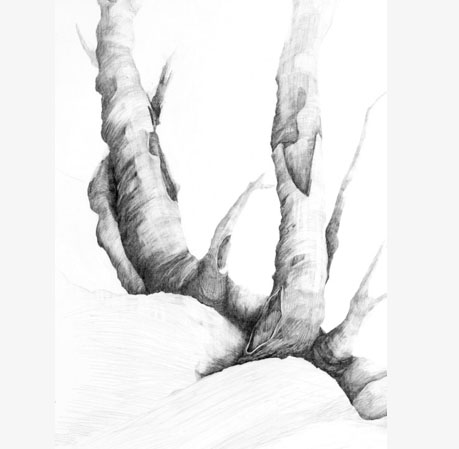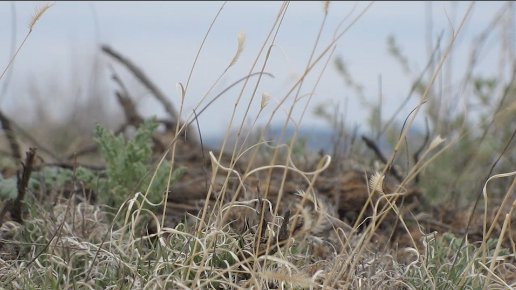
Viewing Megan Vossler’s “Overlooked” landscapes
There’s something so disciplined, almost devotional, in the way of looking Megan Vossler cultivates in “Overlook: Landscape Studies”. It’s not just her attention to detail — although that’s plainly evident. It’s that, in her drawings, one senses a determined effort to see natural landscapes fundamentally differently — not as backdrops to human affairs or as symbols for unspoiled beauty (or, conversely, shameful waste). She seems to set those anthropocentric signifiers aside, instead approaching landscapes as vast, ineffable stories written in an alien tongue; these sketches, then, are her attempts to parse those stories on their own terms. Seen through her eyes, the denizens of the natural landscape follow a parallel (albeit occasionally intersecting) narrative arc to ours, driven by stories which turn on plots dictated by the interplay of more elemental benedictions and calamities.
Vossler’s drawings, in recent years, all have a strong sense of place; indeed, in her last exhibition of work, “Sound Signals” at Franklin Art Works in 2010, the texture and sweep of terrain was central to the effectiveness of her visual storytelling, vital to relaying both the menace and refuge nature offers the human figures in that dystopic series of drawings. In a way, these new landscape studies feel like an inevitable outgrowth of that interest in the land evident in her earlier work — like character development.
The selection of landscape studies on view in the show — a mix of photography, video and drawings — represents an international assortment of locales. It’s quiet work, most of it drawn from the artist’s direct experience of the places depicted and endowed with a traveler’s keen sense for the singular details that distinguish one place from another. A few are more mediated pieces (and a bit less effective, as a result of that filter, to my eye), responses to various landscapes’ representations in others’ artwork (i.e. Ivan Shishkin, Titian).
The stories these works tell aren’t immediately transparent but rewarding all the same; Vossler’s studies ask of the viewer some of the same contemplative attention, the same willingness to look, that fueled their creation. It’s clear, the artist is driven by questions rather than answers: How does one best represent a landscape? How can you translate an experience of place visually, how it feels to be there and to know it intimately? How does choice of medium, or subject, or even definitions of terms shade that representation?
“What is a landscape, anyway?” she asks in her artist statement.
A number of drawings in the exhibit are akin to figure studies — examinations of movement and texture, of an impulse captured in the moment of reaching. Here, a corkscrew branch twists, season by season, to find the sun; over here, a depiction of the point where knotty root systems meet at ground level, limbs intertwined like lovers.
In other works, her focus tends more toward abstraction, examinations of curve and line: the triangular planes that emerge as wind plays on water; the elegant, smoothed angles of a fallen tree gradually overtaken by ground cover. Some of the drawings explicitly investigate movement in what we usually consider immovable landmarks: a gesture of steady uplift in sedimentary accumulation, a canyon’s diminishment over time by wind and water; sunlight’s path, writ by the leaves and blades of grass turning to catch it. Seen through Vossler’s eyes, the kinetic play of these elements in the landscape looks like breathing.
While I’m especially drawn to Vossler’s drawings, her video and photography offer a compelling counterpoint, as if elaborations on a point in an ongoing conversation between her work in different mediums.
“Overlook: Landscape Studies by Megan Vossler” is on view through March 9 at the Macalester College Art Gallery, 1665 Princeton Ave., St. Paul, Minn. Gallery hours are 10 a.m. to 4 p.m. Monday, Tuesday, Wednesday and Friday; 10 a.m. to 8 p.m. Thursday; noon to 4 p.m. Saturday and Sunday. Admission is free.
Recent Content
-
Artsarticle ·
-
Artsarticle ·
-
Artsarticle ·


